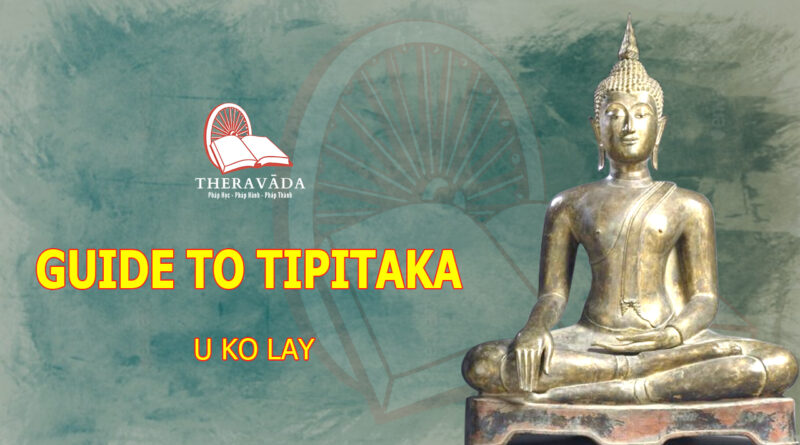Guide To Tipitaka
U Ko Lay
The Buddha is an Arahat and he is worthy of the highest veneration. All beings including devas and Brahmas venerate the Buddha because the Buddha is the Supreme One, who has extinguished all defilements, who has become perfectly self-enlightened through realization of the Four Noble Truths, and who is endowed with the six great qualities of glory, namely, Issariya (supremacy), Dhamma (Knowledge of the Path to Nibbana), Yasa (fame and following), Siri (noble splendour of appearance), Kama (power of accomplishment) and Payatta (diligent mindfulness).
GUIDE TO TIPITAKA Preface
The Tipitaka is an extensive body of Canonical Pæ1i literature in which are enshrined the Teachings of Gotama Buddha expounded for forty-five years from the time of his Enlightenment to his parinibbana.
The discourses of the Buddha cover a wide field of subjects and are made up of exhortations, expositions and injunctions.
Even from the earliest times some kind of classification and systematization of the Buddha’s Teachings had been made to facilitate memorization, since only verbal transmission was employed to pass on the Teachings from generation to generation. Three months after the parinibbæna of the Buddha, the great disciples recited together all the Teachings of their Master, after compiling them systematically and carefully classifying them under different heads into specialized sections.
The general discourses and sermons intended for both the bhikkhus and lay disciples, delivered by the Buddha on various occasions (together with a few discourses delivered by some of his distinguished disciples), are collected and classified in a great division known as the Suttanta Pitaka.
The great division in which are incorporated injunctions and admonitions of the Buddha on modes of conduct, and restraints on both bodily and verbal actions of bhikkhus and bhikkhunis, which form rules of discipline for them, is called the Vinaya Pitaka.
The philosophical aspect of the Buddha’s Teaching, more profound and abstract than the discourses of the Suttanta Pitaka, is classified under the great division known as the Abhidhamma Pitaka. Abhidhamma deals with ultimate Truths, expounds ultimate Truths and investigates Mind and Matter and the relationship between them.
All that the Buddha taught forms the subject matter and substance of the Pali Canon, which is divided into these three divisions called Pitakas — literally baskets. Hence Tipitaka means three baskets or three separate divisions of the Buddha’s Teaching. Here the metaphor ‘basket’ signifies not so much the function of ‘storing up’ anything put into it as its use as a receptacle in which things are handed on or passed on from one to another like carrying away of earth from an excavation site by a line of workers.
The Tipitaka into which the Pali Canon is systematically divided and handed down from generation to generation together with Commentaries forms the huge collection of literary works which the bhikkhus of the Order have to learn, study and memorize in discharge of their gantha dhura, the duty of studying.
TẢI MOBILE APP PHẬT GIÁO THERAVĀDA ĐỂ XEM THÊM NHIỀU THÔNG TIN HỮU ÍCH (ANDROID & IOS)

